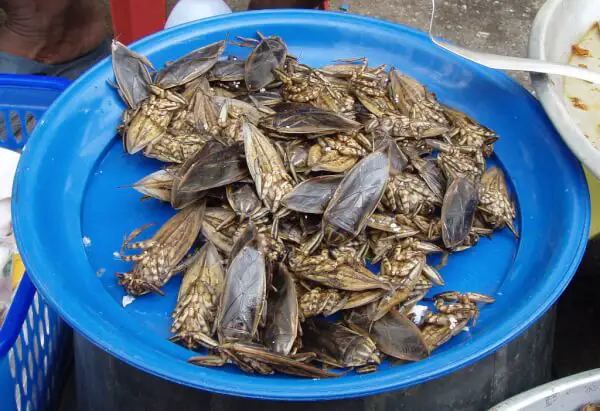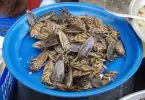Most people who spend any time outdoors have a plan in case of emergency. Smart bushcrafters know shelter, fire, and water are the top priorities in any survival situation. Taking care of these three necessities will greatly improve your chances of living through the worst mother nature throws your way.
See also: Desert Survival Kit: The Essentials You Need Before Heading Out
Food is a different story. Outdoor enthusiasts trust they will be able to forage off the land and find what they need for sustenance. This is not a bad idea if the fish are biting or berries are in season, but if not, you just might find yourself relying on edible bugs to keep the calorie count high and your body moving toward rescue.
Although the human body can go many days without food, the cost is extreme. In a survival situation, it is never wise to allow your energy stores to drop to the point where you cannot continue to work for rescue. On average, a typical male needs 1800 calories per day to maintain current weight and 1200 per day to reduce the risk of metabolic changes brought on by starvation.
In the absence of significant food reserves, calories will need to be found in the wild after a short time. If hunting or fishing is not an option, insects might be the only stable food source to be had.
Overcoming a Cultural Bias Against Bugs
Throughout North America and Europe, eating insects is not popular. For whatever reason, insects don’t often appear on the menu, and there is no tradition or folklore to guide you if finding bugs you can eat becomes critical to survival. Of course, sometimes living trumps comfort and in this case setting aside your cultural bias is the best course of action if you plan on returning home from a dangerous situation.
Eating bugs or entomophagy, has been around for thousands of years. Texts from ancient Greece describe supping on locusts. So does the Bible. Ancient Asian and African civilizations thrived on an insect-rich diet, and the practice still occurs in those parts of the world today.
A Healthy and Sustainable Alternative
More than 70% of the modern world’s population include insects in their diet. Some cultures view winged creatures as delicacies while others view crawling critters as an everyday staple. This practice has proven that humans can not only survive on insects, but they can also thrive.
Insects provide a high level of protein for their weight. They are an excellent source of healthy fats and carbohydrates as well. As a bonus, many essential minerals and vitamins are included in these crunchy snacks making them an excellent addition to any meal.
A big reason insects are so nutritious is the practice of eating the entire creature. The shells and organs contain nutrients that meat alone does not. By eating the entire bug, nothing is wasted, and nutritional benefits that are normally lost are gained.
Which Insects are Approved to Eat?
Insects are the most plentiful animal on earth with over one million different species. A great many are safe to eat. Here is a list of options if you find yourself with a hankering for something crunchy while out on the trail.
- Anoplura – lice
- Orthoptera – grasshoppers, crickets and cockroaches
- Hemiptera – true bugs
- Homoptera – cicadas and treehoppers
- Hymenoptera – bees, ants, and wasps
- Diptera – flies and mosquitoes
- Coleoptera – beetles
- Lepidoptera – butterflies and moths
- Megaloptera – alderflies and dobsonflies
- Odonata – dragonflies and damselflies
- Ephemeroptera – mayflies
- Trichoptera – caddisflies
- Plecoptera – stoneflies
- Neuroptera – lacewings and antlions
- Isoptera – termites
With such an extensive list of choices, finding food when stranded should never be a problem. Mustering the courage to nibble at the belly of a mayfly might pose an issue, however. The key is remembering that survival is key and each mouth full of bugs brings you one step closer to home.
Best Bugs for Survival
Although every insect on this list will do in a pinch, some are better targets than others. Sticking to larger insects is a good bet. As is finding bugs in large groups.
- Crickets are a versatile food which tastes great and provides a good deal of protein. Crickets love sugar and an impromptu trap can be set using a jar. Crickets are best when dry roasted. They can be eaten whole or ground into powder to be used in broth.
- Grasshoppers are quick during the day but become lethargic when exposed to cold. To catch grasshoppers, hunt early in the morning before they have a chance to warm up. Doing so will make harvesting easy. Grasshoppers can be prepared the same way as crickets.
- Locusts are similar to crickets and grasshoppers and can be caught in much the same way. Another hunting method is to use a light at night. Locusts are normally dry roasted and eaten whole.
- Ants are plentiful in the outdoors. To catch enough to make a meal, insert a stick into their nest and shake them into a hot pan. Cook ants quickly because they release acid when agitated which affects their flavor.
- Termites are another nesting insect that can be a great source of protein. The stick method works well for hunting termites, and they are prepared much the same way as ants.
- Beetles can be found in most downed trees and among fallen leaves on the forest floor. Beetles turn wood cellulose into digestible fat and protein. Collect a handful, throw them in a pan, and eat them like popcorn for a delicious and nutritious snack.
- Butterflies and Moths may not be very edible once mature, but in their larval stages, they are a great way to keep hunger at bay. Many cultures across the world treat moth larvae as a delicacy, even soaking one type in tequila in a traditional preparation.
- Bees and Wasps are highly sought after foods in some places. It is best to eat them in their developmental stages before stingers emerge. Stingless bees are fair game in all stages, however. Roasted bees are said to taste like almonds while wasps have a pine nut flavor.
- Stinkbugs are not a likely choice for a meal, but they are known to contain protein and iodine. An acquired taste, those who enjoy eating this insect claim the flavor is similar to apples.
- Maggots are one of the least appetizing insects around, but they are extremely nutritious and can be found in large quantities. Roasted, their texture becomes meaty with a nutty flavor.
For more tips on how to survive in the woods, see our article on the topic for information.
Bugs to Avoid
Although more than 1900 species of insects are known to be edible, there are many which are best left alone. Here are a few tips to help avoid harmful insects when searching for the perfect meal.
- If you have a shellfish allergy, it is possible you will react poorly to eating insects. Because of the risk of anaphylaxis, great care should be taken if you fall in this category.
- Insects commonly known to carry disease such as mosquitos should be approached with caution. Known venomous species should also be left alone.
- As a rule of thumb, brightly colored insects are to be avoided if you cannot identify them. Bright colors are a sign of poison in nature and although not a foolproof indicator, there is no reason to take a chance when such an abundance of other insects can be had.
- Slow moving insects are not a good choice. Insects that move slowly do so for a reason. Nothing wants to eat them because of the toxins they create.
- Caterpillars are both slow moving and brightly colored, but many are excellent to eat and are high in protein and other nutrients. Stay away from red, black, and purple varieties as this is often a sign the caterpillar has been feeding on toxic vegetation.
- If you are in an area which sprays herbicides on plants, be careful when harvesting leaf-eating insects. Poisons can be transferred to you by the bug, causing severe illness if ingested in large quantities.
- Do not eat bugs you find dead. You do not know what killed the insect and chances are the same thing could be harmful to you.
Insect Cooking Tips
Most insects do not need to be cooked before being eaten, but they taste better out of a pan. Dry roasting and boiling are two proven ways to prepare most bugs. Skewers are a great implement for grilling over an open fire as are leaf packets to contain your harvest on the fire.
If you are uneasy about the texture created by crunching into a beetle or cricket, try pulling off the legs wings and heads. You will be losing very little nutritional value and making the experience far more palatable.
Insects taste better with ample spice. As with most things, introducing other more dominant flavors will mask unpleasant tastes and even aromas. Used in broth, some black pepper can change the flavor profile of most bugs enough to choke down even the most unappetizing meal.
Mixing bugs with edible plants will make them more enjoyable. You need vitamins from plants anyway so why not mix all of your food together? Who knows, you might come up with a recipe you really enjoy for future meals.
Are Insects Becoming the New Beef?
Worldwide almost 2 billion people eat insects as part of their regular diet. Many experts predict that insects will eventually become the primary source of protein on the planet in the next fifty years. The United Nations has issued strong recommendations for the development of insect-based dietary supplements after studying the cuisine of Africa and Southeast Asia while searching for new food sources in developing countries.
The reason for this push is sustainability. Insects require very little land to raise and require far less water than other protein producing livestock. Compared to cattle, insects hardly make a dent on their environment.
The average insect goes from hatching to maturity in less than seven weeks. A cow takes up to three years. This means far faster production cycles which brings more food to market when it is needed.
Insects contain protein with all seven of the essential amino acids. And, they are an excellent source of healthy fats. Included in the package is a healthy dose of carbohydrates and minerals. When compared to traditional protein sources, bugs are a super food.
Can Insects Replace Wheat?
Bugs don’t just have their eyes on replacing meat; they can be used to produce flour also. Dried crickets ground into powder are now on the market as a grain substitute. This product boasts a gluten-free label and fewer starches and sugars than traditional wheat. All while providing a high concentrate of protein. The flavor is said to be nutty and pleasant.
Cricket flour products are already on the shelves. From bread to chips, these insect-based items are being touted as the next generation of food. So far, consumer response has been lukewarm at best, but it is too early to tell if the trend will take off or fail.
Mealworms are another protein substitute with designs on changing the way we eat. Mixed with vegetables in a colorful spread, the product claims to provide a healthy alternative to popular dips in the snack aisle. Mixed with chickpeas, mealworm falafel is also readily available in many European markets.
The Ick Factor is A Barrier to Acceptance
Consumer response to foods made from bugs has yet to be overwhelmingly positive. People do not want to buy crickets or worms for one reason. It is gross.
Although hardly scientific or based on experience, this negative feeling is strong. In order for insects to gain a real share of the North American and European food industry people will have to accept eating bugs as normal. A change that drastic will take time.
Proponents of entomophagy are taking a slow road to acceptance by introducing products which disguise the animals they contain. Powders and purees don’t have an antenna or spiked legs. Yet customers are not lining up.
The manufacturers of “ento-cuisine” are not phased. They liken the process to sushi’s introduction to the same markets. What was once avoided as disgusting raw fish is now a major part of the restaurant industry. Bug food makers are hoping for the same path to success.
There is light at the end of the tunnel for the cricket flour and mealworm falafel supporters. A survey conducted in the United States showed that consumers were at least open to the idea of lunching on bugs. In the poll, almost three-quarters indicated they would rather eat an insect than raw goat meat and a little more than half would munch a bug in lieu of enduring ten minutes of pain.
Other Uses for Insects in the Food Industry
Content to wait for popular opinion to change, insect food manufacturers have begun tackling sustainability in other ways. One target for insect products is producing feed for other animals higher on the food chain.
By warehousing millions of flies, maggots can be harvested, dried and ground into meal. This produces a serviceable chicken feed for commercial farms across the world. Compared to growing corn, the fly manufacturing plants use very little resources. And, the maggot meal more closely resembles a chicken’s natural food selection than the current feed ever will.
If these new chicken feed operations are successful, plans include the manufacture of feed for cattle, sheep, and goats. In this way, the environmental benefits of insects can be taken advantage of by only indirectly contributing to the food supply.
For Now, Insects Remain a Survival Food
Although there might be a bright future ahead, for now, insects will stay in the back rooms of the culinary world. Until such a time when people are comfortable eating crickets for breakfast and beetles for lunch, entomophagy will most likely be relegated to fringe restaurants and survival specialists.
It is good to know that insects can be eaten safely and will provide enough nutrients to keep your body going if you ever are in a situation with no other food source. In fact, the research shows that you can thrive by eating insects whether in survival mode or not.
To truly prepare for a situation which could require eating insects, it is best to have some familiarity with ingesting them. It is hard to guess how you will react when faced with a handful of termites until that moment comes. To understand your limits, it would be wise to try a bug or two in advance of a real survival situation if only to gain confidence for the real event.
Insects are a Great Option When Food is Scarce
When the chips are down and eating something is a matter of life or death, insects are a great option to have. They are plentiful, nutritious, and can be found in every part of the world. Yes, some of them are not the most appetizing snacks around, but in the quest for calories, beggars can’t be choosers. For more edible insects you can consume for survival, check our list to find out.
Featured Image Source: “Edible Bugs” by Basil & Tracy is licensed under CC BY-NC 2.0







